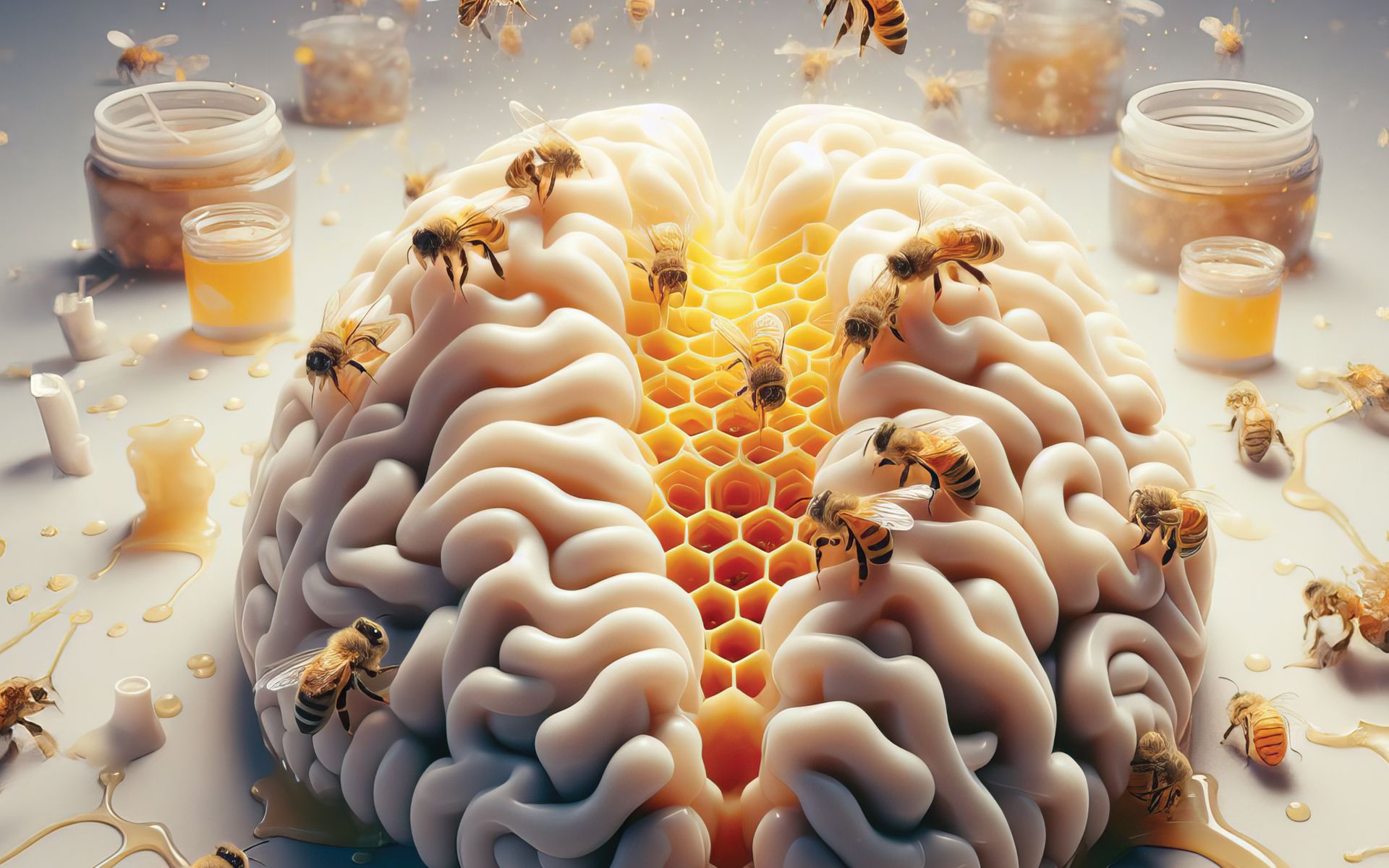Are Brains the Source?

In This Article
-
The diversity and complexity of life challenge us to seek wisdom, and an all-comprehensive knowledge and power beyond a materialistic and naturalistic framework.
-
How are these social insects directed to do all these activities? Are these originating from the neurons in their brains or are they somehow inspired internally or guided by some kind of a revelation? How is the genetic basis processed and transmitted to offspring? What serves as the source of willpower, knowledge, and consciousness behind these algorithmic calculations?
-
The algorithms governing these specialized productions by spiders are encoded in their genomes. While a multitude of genes may serve as visible "causes" for such behaviors, they do not provide satisfactory answers for discerning minds and hearts seeking to understand how, for instance, spiders possess the chemical formula for silk and the engineering knowledge behind their intricate webs.
-
Attributing this perfect system solely to nature and blind chance, without acknowledging its irreducible complexity, puts an already difficult task in a complete bind. Similar to animal migration, the interdependence and integration of numerous programmed behavioral systems invalidate explanations solely based on mere chance.
-
The sophisticated and highly integrated programming, along with the rich algorithms found in the micro-brains of social insects and other animals, strongly suggests a source of infinite knowledge and a teleological orientation.
There are many mysterious aspects of animal behavior which keep mesmerizing scientists. Zoologists dedicate their research to unravel these mysteries, not only to gain insights for our improvement, but also to understand the similarities and differences between animal and human behaviors. A great majority of human behaviors are learned after birth, guided by reason and choice, and even prime in accordance with the moral norms prevailing in society – the scope and nature of human development and the distance a human being covers throughout far exceeds that of animals.
Many of the daily activities carried out by humans and animals may look simple from the outside, but upon closer examination, we realize each to be pretty complex. Choosing the right nest for rest, ensuring the safety of offspring and food, even the seemingly straightforward task of finding the way back to the nest from long distances involve a series of complex actions fulfilled in the right order. Many animals engage in even more mysterious activities, such as exhibiting government-like social structures among bees, termites, and ants, navigating across long distances and determining migration routes, building nests with specific architectural designs, detecting and transporting nectar sources, making honeycombs, and many more. One can’t help but wonder the underlying algorithm that governs these mysterious behaviors. How are these social insects directed to do all these activities? Are these originating from the neurons in their brains or are they somehow inspired internally or guided by some kind of a revelation? How is the genetic basis processed and transmitted to offspring? What serves as the source of willpower, knowledge, and consciousness behind these algorithmic calculations?
The diversity and complexity of life challenge us to seek wisdom, and an all-comprehensive knowledge and power beyond a materialistic and naturalistic framework. Contrary to claims made by some scientists, attributing these astonishing behaviors to such a power opens doors to a wider range of research.
Measure, order, and algorithm
When we hear the word “algorithm,” we immediately think of the concepts of computation and programming. Algorithms are at the heart of many branches of mathematics and engineering, and they appear in many aspects of modern daily life. Examples of algorithms are found on internet search engines such as Google, smartphones, route orientation with geographic positioning (GPS), voice recognition and more. Navigation apps in your car use complex algorithms to calculate the most efficient route to the desired destination, determining which of several possible routes will be the fastest. And of course, we all acknowledge the fact that such algorithms are not there as a result of a blind material process happening by chance; they are each a product of intelligence and are there for a reason.
Animal architecture
Spiders are one of the master engineers of the book of nature. Take, for instance, the golden orb weaver spider, equipped with seven types of silk glands producing six strands. These threads serve diverse purposes, from weaving webs, to wrapping prey and shielding eggs. Despite great efforts and expenses, mankind has yet to replicate materials equivalent to these spider silks, known for their strength surpassing that of steel of the same thickness, more stretchable than rubber, and adhesive properties superior to most tapes. The algorithms governing these specialized productions by spiders are encoded in their genomes. While a multitude of genes may serve as visible “causes” for such behaviors, they do not provide satisfactory answers for discerning minds and hearts seeking to understand how, for instance, spiders possess the chemical formula for silk and the engineering knowledge behind their intricate webs.
Social insects
Zoologists classify bees, termites, and ants as "social insects" due to their intricate societal structures that operate akin to a government, displaying mind-boggling functionalities within their colonies. How is this phenomenon possible? Did these insects learn to establish a “state” through a process of trial and error and education over many years? How many attempts and failures did it take for them to reach this level of sophistication?
Desert ants have brains roughly a quarter the size of honeybees' brains. Despite this size difference, studies of their foraging trips reveal a remarkable ability for pathway integration. This capacity is not learned but rather innate, instilled in them naturally. In addition to identifying factors such as sight-based landmarks, fragment details on their routes, a solar compass, a biological clock and an odometer, these ants also use the detection of odors and the sense of chemotaxis (turning to a chemical substance) near a food source. Research shows that ants are also programmed to use which navigation method is suitable for certain meteorological conditions.
It requires an incredible technology to digitally encode the programs transmitted by neurons that underlie both individual behavioral characteristics and the integration of honeybees into the hive community. The Asian honeybee (Apis cerana) is a community based on cooperation. It has only one female and a few males that are reproductively active. In this community the non-breeding individuals care for the young or maintain the group. A genome study of this species showed that they consist of 10,651 genes, about 20% (2,182) of which are unique (not found in other bees). These genes did not exhibit commonalities with the Western Honeybee (Apis mellifera), just as they didn't in other insects that live individually. This contradicts the claims of some scientists who argued that these two species diverged from a common ancestor one or two million years ago. The average length of the Asian Honeybee genes was determined to be 7,577 base pairs. The challenge lies in the fact that for significant beneficial mutations to occur in more than two thousand genes of this length, it would require millions of years, far exceeding the timeline proposed by these scientists.
Honeybees are tasked with many vital activities, including selecting and synthesizing building materials for honeycombs and the entire hive, repairing honeycombs, caring for the brood, and regulating hive temperature. All of these critical elements within a bee colony are interdependent, forming a complex system of behavior, that is irreducible. Attributing this perfect system solely to nature and blind chance, without acknowledging its irreducible complexity, puts an already difficult task in a complete bind. Similar to animal migration, the interdependence and integration of numerous programmed behavioral systems invalidate explanations solely based on mere chance.
Bees operate within a radius of 50-60 km², utilizing various methods—such as sight-based landmarks, the solar compass, and the polarized light compass—to determine direction based on weather conditions. When a “scout” bee returns from exploration, it performs a “swing dance” within the hive, conveying the compass direction and distance to the flower location. Remarkably, this intricate process occurs in the bee brain, which has only 950,000 neurons, compared to the human brain with 85-90 billion neurons. The question arises: Could such a process, involving engineering calculations and complex algorithmic encoding emerge spontaneously in the pinhead-size brains of honeybees? To claim this is tantamount to believing that the construction materials of a multistory building could come together without an engineer, seemingly orchestrating the process independently.
Although termites are similar to bees as social insects, they display qualities that are unique in many ways. Termite communities are structured as multi-generational family groups, where the majority of members collaborate to support a few leaders, occasionally just a single leader. They exhibit remarkable behaviors, constructing mound-shaped nests with impeccable architecture. They employ war tactics to safeguard the gardens where they cultivate mushrooms from potential threats. Additionally, they adeptly control ventilation shafts to regulate the humidity and temperature within the nest. These complex
In mushroom-growing termite communities (Macrotermitinae), the young termites consume both collected plant material and fungal spores. Symbiotic gut bacteria then assist in partially digesting the plant-fungus mixture before excreted as feces. The fungi continue to grow and break down new sources of plant material introduced by older worker termites. From a materialistic perspective, scientists may argue that this tripartite relationship between termites, the bacterial community, and the fungus gradually develops over time. However, explaining how three distinct genomes evolved together to promote this symbiosis poses a challenge. This intricate relationship involves numerous genes from all three species, making it highly improbable that multiple mutations in three different and independent genomes could have occurred in harmony.
Navigation and migration
In migrating animals, the amount of fat they consume for the duration of their journey is crucial. Storing too much fat can lead to fatigue due to excess weight, while too little fat may result in running out of fuel midway through the journey. The balance of fat is essential for the success of their migration. Birds, for instance, are able to choose the route with optimum distance using a compass system that detects polarized light, enabling them to determine the position of the Sun even on cloudy days. Additionally, birds ensure they select the safest route, considering challenging weather conditions like storms, clouds, and rain. Birds can follow a real navigation map based on the positions of stars, detect the earth’s magnetic field, and perceive information about its density and tilt, allowing them to identify latitudes. The black-billed shearwater, for instance, covers 10,000 km with navigation precision surpassing that of a commercial cargo plane.
The challenge of distance calculations on the spherical shape of the Earth is addressed by long-distance migratory birds using a form of knowledge related to spherical geometry, which is intricate due to the absence of straight lines. Consequently, standard (Euclidean) geometry doesn't apply, leading mathematicians to use complex spherical trigonometry for calculations. The intriguing aspect is that we are uncertain how animals, often with relatively small brains, can perform such complex calculations for navigation. Humans, with their larger brains and high intelligence, achieve similar feats using advanced mathematical concepts. It suggests that migratory birds possess an innate programming designed specifically for these navigational tasks
Elucidating the origin of the genetic programming underlying complex migratory behaviors poses a substantial challenge when solely attributing it to material causes and chance. Consider, for example, the legendary migrations of monarch butterflies. During their collective journey spanning four or five thousand kilometers, sometimes two or three generations of migratory birds travel together under cloudy skies, relying on the innate solar compass bestowed upon them by their creation. How much information is needed to be encoded in the genome of a supposedly evolving butterfly for this migration? In fact, when the genomes of migratory monarch butterflies are compared to those of non-migratory monarch butterflies, it has been revealed that more than 500 genes are involved in migration behavior.
The presence of evidence for the role of epigenetics, in addition to genetics, in the migratory behavior of some animals suggests a comprehensive source of knowledge that encompasses all environmental and genetic characteristics. This source conducts changes in a coordinated manner at multiple levels. It becomes challenging to characterize this process as purely scientific if we assert that coordinated genome changes, executed with infallible and perfect precision, could occur through a blind and untargeted process.
Even seemingly simple animal behavior has a genetic basis. In a behavioral study, the sea snail (Aplysia californicus) exhibits a reaction by retracting its gill and siphon into the body mantle when poked. With repeated poking, the snail gradually becomes accustomed to the stimulus, and its reaction diminishes over time. It has been established that this simple habituation response in the sea snail is carried out through a network of about three hundred neurons, including sensory neurons, locomotion neurons, and interneurons. If a basic guard reflex behavior is so neurologically complex, then much more complex programmed behaviors must logically rely on more complex neural mechanisms. Where do we attribute the origin of genetically encoded algorithms and neurological controls that underlie such intricate animal behavior? Specifically, what skilled engineer could have designed and optimized the layout needed to incorporate these algorithms into such small brains?
In conclusion, these intricate systems are encoded in the genomes of various animals, including butterflies, bees, ants, sea turtles, and birds. While some animal behaviorists refer to these complex programmed behaviors as "instincts," the sophisticated and highly integrated programming, along with the rich algorithms found in the micro-brains of social insects and other animals, strongly suggests a source of infinite knowledge and a teleological orientation. Attributing this perfect organization to God is not an obstacle to knowledge and further research.









